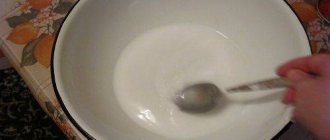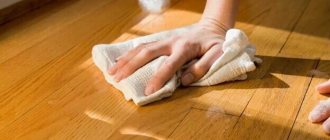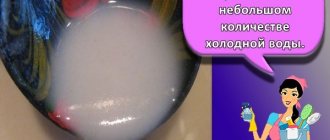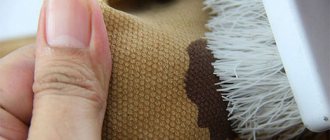Experienced housewives know the secrets of how and what to starch a dress at home. This method is considered by many to be outdated. In fact, starching can transform a familiar item beyond recognition and protect it from possible contamination. The invisible film created by starch on clothes does not allow them to wrinkle - this is another advantage that should not be forgotten.
Products for starching things
There are many means to stiffen fabrics. Moreover, you can use potato, corn and wheat starch. But now products in solutions and sprays have appeared on sale that help save time. There is no need to soak and brew the starch.
Overview of starching products:
- Luxus superform. The product is sold in a bottle with a spray. You just need to shake the bottle and apply the product to dry and clean laundry. Iron. The substance helps to give the linen rigidity and helps maintain its shape for a long time. The linen does not wrinkle.
- Chirton starch. The product is sold in a spray bottle. It is necessary to apply not dry linen and iron it. After this treatment, things will not stand up, but the process of ironing shirts and linen is greatly simplified.
- Ocean starch. This is a product sold in a bottle. It is a solution that is introduced into the washing machine during the rinsing process. Inserted into the mouthwash area.
- Selena starch. This is also a liquid that is introduced into the washing machine into the conditioner compartment. After this, the laundry is easier to iron.
Products for starching things
Products that cannot be starched
There are certain categories of things that are contraindicated to starch. After this they will simply be spoiled.
- Synthetic products never starch. The material is not capable of fully permeating air, and after treatment with such a solution this ability will be completely lost.
- Underwear is also not processed using this method. After the manipulations, it will not allow moisture or air to pass through. It can no longer be called hygienic.
- Clothing made from dark materials usually leaves stains that are extremely difficult to remove.
How to make, dilute and brew starch for starching laundry?
There are several ways:
- Soft starching. Ideal for tulle, light blouses and bed linen. Gives a little stiffness. You need to dilute a teaspoon of potato flour in 220 ml of cold water. Boil 800 ml of water on the stove and add the prepared solution in a thin stream with constant stirring. Let cool and immerse things for 1-2 minutes. Wring them out and dry them.
- Hard starching. This option is used if you need to starch a gauze collar or petticoat. This option allows you to make things tougher. You need to dissolve 2 tablespoons of potato flour in 200 ml of cold water and pour the solution into 800 ml of boiling water while stirring constantly. The fabric is dipped into a viscous solution and wrung out.
How to make, dilute and brew starch for starching laundry?
Solutions options
The concentration is selected taking into account the properties of the materials. Thin and weightless fabrics do not need to be weighed down, so solutions of minimal concentration are prepared for them. And to make a lush tulle tutu or petticoat for a circle skirt, a more concentrated solution is required.
Amount of starch for preparing solutions per 1 liter of water:
- low concentration – 10 g;
- medium – 30 g;
- hard – 60g.
The technology for preparing solutions is the same in all cases:
- take a glass of water from the measured amount;
- The rest of the water is set to boil;
- stir the required amount of starch in the cold water left;
- pour the prepared solution into boiling water with vigorous stirring;
- remove the pan from the heat and leave until cool
It is possible to use two types of solution to process different elements of the outfit. For example, if the dress has a multi-layered skirt, then the lowest layer can be treated with a concentrated solution for pomp. And the subsequent ones are softer. You can starch individual details of the outfit - lace trim, flounces, collars. The solution is applied using a brush or spray.
How to starch laundry in an automatic washing machine?
Instructions:
- Dissolve a spoonful of potato flour in 210 ml cold water
- Boil 210 ml of water and pour in the prepared solution
- Pour the resulting paste into the washing machine dispenser and turn on the rinse mode.
- Dry your items as usual
How to starch laundry in an automatic washing machine?
How to starch a child's, women's, New Year's dress at home?
The easiest way is to use a spray; it is applied while ironing. But if you want to starch the old-fashioned way, follow the instructions.
Instructions:
- Dissolve a spoonful of starch in 200 ml of cold water
- Pour the solution into 200 ml of boiling water and stir
- Immerse the dress in the slippery mixture and let it soak completely.
- Squeeze a little to remove excess moisture
- Hang on a hanger and dry at room temperature, straightening out all the wrinkles
How to starch a child's, women's, New Year's dress at home?
Purpose of the procedure and preparation
The curvaceous shape of a dress does not always depend on the particular cut of the item. Starching will allow you to give your outfit the same look as the snow-white skirts of ballerinas. Almost any housewife can cope with this on her own at home. Proper use of special tools allows not only to give the required shape and volume, but also to maximize the freshness of the material. A similar effect is ensured by the formation of a film on the fabric during its treatment with solutions. This artificially created layer has the following unique properties:
- significantly improves the resistance of the material to the formation of folds and creases by increasing rigidity;
- dirt is absorbed less easily, which in turn makes the washing process much easier;
- after treatment, a yellowed item becomes almost snow-white;
- the dress can be used for much longer, and at the same time it does not lose its presentable appearance;
- starch allows you to highlight elements such as bows, cuffs, collars and ruffles.
The key to success is proper preparation of the item. Before starching, the product must be thoroughly washed and checked for any remaining stains. The thing must be carefully examined in the presence of a stable light source.
Advice! Detected stains or yellowish deposits can always be quickly and effectively eliminated using a hydrogen peroxide solution.
The recipe for this product is very simple and to prepare it you will need:
- 200 ml water.
- 2 teaspoons peroxide.
- To stir thoroughly.
The solution should be applied to contaminated areas and the dress should be left to dry, preferably without exposure to technical means. In other words, the item must dry on its own. The best conditions will be fresh air and sunshine. This way you can get rid of almost any stains. If, after treating with peroxide, minor imperfections still remain, do not despair, since starch will cope with them perfectly.
How to starch gauze and bandages for laboratory work?
Often a bandage is needed for laboratory work. In this case, you will have to try a little.
Instructions:
- Dilute a spoonful of starch in 250 ml of water
- Pour the solution into a glass of boiling water and keep on fire with constant stirring
- Cool the resulting jelly and immerse the bandage in it.
- Wring out the bandage and hang it to dry
- Iron the dried bandage and roll it into a roll.
How to starch gauze and bandages for laboratory work?
How to starch a wedding dress and veil?
The veil and dress are made of synthetic material. At the same time, even when sewing a dress, it is starched and ironed. During careful washing in cool water, this layer is not washed off, and the dress keeps its shape. But if the dress has been rented several times, then it might be worth starching it. To do this, you should use aerosol products. They are applied directly to the fabric before ironing. The following products can be considered the most effective: Luxus superform and Chirton starch.
How to starch a wedding dress and veil?
Important points and valuable recommendations
Children's outfits vary, depending on the specific events for which they are designed. It is for this reason that it should be borne in mind that many textile products can be starched, with the exception of:
- Things that come into contact with the body. This is explained by the fact that the fabric after such treatment becomes almost completely waterproof, which is extremely undesirable from a hygiene point of view. In such situations, starching of individual elements is allowed.
- Dresses made of black fabric, since treatment with a starch solution or using commercial household chemicals can cause the formation of white spots.
- Items made entirely or partially from synthetic materials.
Important! The starching procedure is most relevant for evening dresses and petticoats. As well as knitted dresses and products made from natural fabrics.
Sometimes, after treatment, the item may stick to the soleplate of the iron during ironing. To prevent such situations, experienced housewives advise adding a few drops of turpentine to the paste. Adding half a teaspoon of regular salt or a little blue to the homemade mixture will help add a special shine to your dress. The second option involves thorough mixing to eliminate lumps.
Might be interesting
- The best means and methods for washing children's clothes The appearance of a baby in the family is the reason for daily washing. It is for this reason that it is important for new parents...
- The best ways to starch shirts Starch has fixing properties. A shirt whose cuffs and collar have been starched looks attractive...
- The best ways to compactly fold a sweater The ability to correctly fold a sweater for storing or transporting a product will allow you to preserve its appearance,…
How to starch a medical gown, a doctor's and chef's cap, bed linen, and tablecloth?
These products are made of cotton fabric. In these cases, starching is used to improve the shape of the product and ensure that wrinkles and bruises do not form. For this purpose, mild starching is sufficient. That is, clothes or linen are rinsed in a weak starch solution. The soft starching method is described in more detail above.
How to starch a medical gown, a doctor's and chef's cap, bed linen, and tablecloth?
What to do with a children's outfit?
Lush outfits are appropriate for children's parties in the garden. They starch the outfit in the manner described above: they work only with the petticoat, and do not touch the overskirts. If there is no petticoat, then the skirt itself is processed. While the fabric is still damp, smooth the fabric.
- Starching a petticoat is not difficult. But you shouldn’t wait for it to dry completely: it will be hard, and it will be difficult to shape it. It is better to iron it slightly damp. A petticoat that is too full is straightened, paying special attention to details and folds.
Tulle skirts similar to ballet tutus are starched as follows:
- carefully apply the mixture with a sponge to each layer. First they work with the bottom one;
It is not necessary to touch the top layers, everything is optional;
cannot be dried in frost or heat;
Iron the top layer thoroughly.
Don't get to shape:
- black things. The mixture will leave white spots;
synthetic fiber clothing;
- underwear. This is not recommended, as the fabric will become waterproof. It's not good for the skin.
Starch is an excellent substance for giving shape to a skirt or party dress.
To get an elegant, spectacular dress, try starching it. In addition to its pleasant appearance, it will become less wrinkled and dirty. The starching procedure is quite simple and can be done at home.
How to starch lace, bow, satin ribbons for rhythmic gymnastics?
To starch such fabric you will need gentle starching. Half a teaspoon per liter of water is enough for organza (bows) and a teaspoon for starching satin ribbons. You can find out more about preparing the solution above.
How to starch lace, bow, satin ribbons for rhythmic gymnastics?
Why starch clothes?
Before we learn how to starch clothes, let's figure out why it's even needed. So, using this method allows you to:
- give things additional volume and beautiful shape;
- keep clothes fresh and clean longer (when washed, the protective layer of starch will be washed off along with dirt);
- maintain an attractive appearance, since starched items wrinkle much less;
- emphasize individual elements - collars and cuffs.
Is it possible and how to starch black and colored lace and fabrics?
It is worth noting that after using starch, stains or white streaks may remain on dark or colored items. In this case, it is better to use gelatin instead of starch.
Instructions:
- Soak a sachet of gelatin in cold water (100 ml) for 5 minutes to soften it, drain the water and bring 0.5 liters of water to a boil
- Add softened gelatin and cook, stirring, until completely dissolved. Cool the solution until warm before use.
- There will be no traces left, gelatin covers the fibers with a transparent film
Is it possible and how to starch black and colored lace and fabrics?
Features of drying and ironing starched products
The last stage is no less important than the preparation and the procedure itself. Firstly, it is important to dry the product properly. To do this, it needs to be well and carefully leveled so that all the folds, frills and flounces become smooth and identical. The peculiarity of starch is that when it dries, it holds its shape, and if you do not immediately pay attention to small details, it will be difficult to smooth them out later.
It is best to dry a child's or adult's dress on hangers in a vertical position. A balcony or open terrace is the best place, but only in the warm season. Winter frost and cold are contraindicated for drying products after starching.
To properly iron an item and secure the effect, you need to start before the item is completely dry. Slightly damp fabric is much easier to iron. In this case, the iron setting should be set to a medium level, and it is better to iron delicate and thin fabrics, for example, chiffon, through gauze.
The starching effect will last until the next wash, so some items, for example, a child's dress for performances and dances, will have to be processed every time. However, the simplicity of the procedure and the short amount of time it takes make the effort easier.
Is it possible and how to starch a black and colored dress, a black skirt, black trousers?
Starch should not be used for dark, black and colored items. For this purpose, use gelatin. Instructions for using gelatin are above.
Is it possible and how to starch a black and colored dress, a black skirt, black trousers?
Drying rules
There are several recommendations that you should familiarize yourself with before drying treated clothing.
Hangers
When drying naturally, all wet items must be hung on special hangers. These products allow you to maintain the shape of the dress and prevent them from wrinkling during the drying process. Hangers with clothes are hung on special fastenings at a level of one and a half meters above the floor surface so that the fabric does not come into contact with it.
Room temperature
When drying things, you need to monitor the temperature in the room. They should not be too low or high, as this may affect drying. The temperature in the room where the treated dresses are dried should be 20-23 degrees Celsius.
How to starch a napkin with sugar?
For starching, you can use not only starch and gelatin, but also sugar. For this purpose, you need to prepare sugar syrup.
Instructions:
- Dissolve 8 tablespoons of sugar in a liter of water and bring the solution to a boil
- Cool the syrup slightly until it becomes warm
- Soak the wipes in the solution for 15 minutes
- Dry items at room temperature
- Pat as usual
How to starch a napkin with sugar?
Fabric processing
Before soaking the dress, cool the finished solution until it reaches room temperature. Otherwise, there is a high probability of damage to the item during processing.
The mixture can be pre-tested. To do this, dip your hand into the solution. If the mixture feels slippery and sticky to the touch, everything is done correctly.
Now you can starch the dress. It is lowered into the container, straightening out all the folds so that the fabric evenly absorbs the starch liquid. To obtain the desired result, 10–20 minutes of soaking is enough. Then the dress is taken out, gently wrung out, and inspected to see if the mixture has been applied evenly to all places.
How to starch a dress for pomp using selenium solution?
There are special products for starching clothes. One of them is Selena. It is necessary to dissolve the amount of product indicated on the bottle in a liter of water and immerse clothing in the solution. It is necessary for the dress to lie in the solution for 15 minutes. After this, the clothes are wrung out and dried at room temperature. All folds must first be smoothed out.
How to properly starch a board for fluffiness with a selenium solution?
Why do you need to starch your dress?
Starching is not suitable for all types of clothing. There is no need to apply starch to fine knits, chiffon, wool or silk. It makes sense to starch something made from cotton, viscose, or synthetic fabric. For which dresses can you use starch?
- For children. Thanks to starch, you can add unprecedented splendor and freshness to elegant clothes. The technology is also suitable for caring for school uniforms. Applying the composition will reduce the amount of ingrained contaminants: ballpoint pen paste, corrector, glue. Before starching a child's dress, you should calculate the amount of product. If the norm is exceeded, there is a risk that the clothes will prick and irritate the skin.
- For weddings. You can create a fabulous look by applying the product to the hem of the dress. For products with a little splendor, starch can replace the frame rings that are becoming a thing of the past. In addition, starch can be applied to the lace decorative elements of the dress. This will add special solemnity and accuracy.
- For office workers. Starched collars and hems allow you to get rid of static electricity and emphasize the impeccability of your look.
- For everyday. Casual summer and spring dresses, slightly thickened with starch, look great.
It should be remembered that regular starching of clothes significantly increases the wear life of the product, reduces wrinkles and makes washing easier.
How to starch the hem of a dress?
This is partial starching, which is used to make the hem heavier. At the same time, the skirt becomes quite heavy, it smoothes out perfectly. This starching is suitable for sun-flared or “beauty” cut dresses and skirts. Hard starching is used, which is described above. In this case, you do not need to dip the entire product into the solution, but only the lower part. You need to wring it out and hang the dress on a hanger.
How to starch the hem of a dress?
As you can see, with the help of starch you can give things a neat and beautiful look. This will make your clothes neat.
Tips for special occasions
There are several recommendations for special cases.
Wedding
It is not necessary to starch the upper part of wedding dresses, especially if it is made in the form of a corset. You only need to starch the lower part where the skirt is located. It is covered with a napkin soaked in a starch solution and ironed. The procedure is repeated 2-3 times.
Children's New Year's
Sometimes children have to prepare a New Year's outfit and starch it. To do this, the product is completely wetted in a starch solution, after which it is ironed. If after this the New Year's dress is wrinkled, you will have to repeat the procedure using hard starching.
Cuffs and collars
To starch collars with cuffs, as in the case of a child's New Year's dress, it is better to use a hard solution. To increase its effectiveness, a little sodium boric salt is added to the composition. Then the liquid is brought to a boil and left for an hour and a half. After this, you can put things into the prepared paste.
See also
How to properly care for plastic windows with your own hands, a review of the best products
Knitted
To make knitted clothes more beautiful, people recommend starching them. Thanks to this, the treated clothes will become brighter, stop stretching and will better retain their shape. Also, the patterns on the surface of knitted items will become much larger and more prominent.
Skirt
Tulle and other materials from which a petticoat or skirt can be made must be starched periodically. To do this, it is necessary to use solutions of medium hardness or light starch mixtures. Things are soaked in them for 20-30 minutes, after which they are dried a little and ironed to get rid of bruises.











